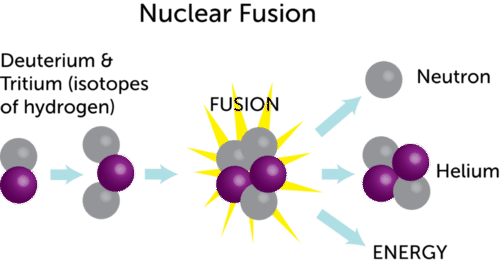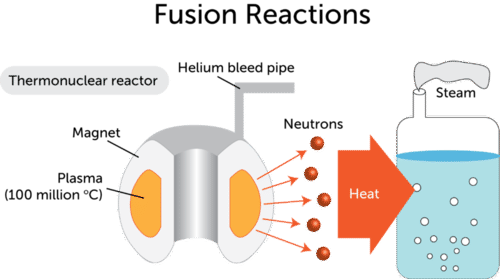8.11 核熔化
章节大纲
-
What causes the sun to glow so brightly? The answer is nuclear fusion. Nuclear fusion is a type of nuclear reaction, and it releases a huge amount of .
::核聚变是核反应的一种核反应,它释放出大量的核辐射。What Is Nuclear Fusion?
::核聚变是什么?In nuclear fusion , two or more small nuclei combine to form a single, larger nucleus. You can see an example in the Figure . In this example, nuclei of two hydrogen , tritium ( ) and deuterium ( ), fuse to form a helium nucleus ( ). A and a tremendous amount of energy are also released.
::在核聚变中,两个或两个以上小核结合成一个单一的、更大的核核。您可以看到图中的一个实例。在这个例子中,两个氢的核(13H)和(12H),结合成一个核(24H)。A和大量的能量也释放出来。Nuclear Fusion The Power of Stars
::星星的力量Nuclear fusion of hydrogen to form helium occurs naturally in the sun and other stars. It takes place only at extremely high temperatures. That’s because a great deal of energy is needed to overcome the force of repulsion between the positively charged nuclei. The sun’s energy comes from fusion in its core, shown in the Figure . In the core, temperatures reach millions of degrees Kelvin.
::氢的核聚变自然会发生在太阳和其他恒星中。 它只有在极高的温度下才能发生。 这是因为需要大量能量来克服正电核心之间的反弹力。 太阳的能量来自核心的核聚变,如图所示。 在核心中,温度达到千千万万开尔文的华氏度。The Sun Q : Why doesn’t nuclear fusion occur naturally on Earth?
::问:为什么核聚变不会自然地发生在地球上?A : Nuclear fusion doesn’t occur naturally on Earth because it requires temperatures far higher than Earth temperatures.
::A:核聚变不会自然地在地球上发生, 因为它需要比地球温度高得多的温度。Using Nuclear Fusion
::利用核熔化Scientists are searching for ways to create controlled nuclear fusion reactions on Earth. Their goal is develop nuclear fusion power plants, where the energy from fusion of hydrogen nuclei can be converted to electricity. You can see how this might work in the Figure . In the thermonuclear reactor, radiation from fusion is used to water and produce steam. The steam can then be used to turn a turbine and generate electricity.
::科学家们正在寻找在地球上制造受控核聚变反应的方法。他们的目标是发展核聚变发电厂,将氢核聚变的能量转换成电力。你可以从图中看出这一点。在热核反应堆中,聚变的辐射被用于水和蒸汽。然后蒸汽可以用来转换涡轮机和发电。The use of nuclear fusion for energy has several pros. Unlike , which involves radioactive which take hundreds of thousands of years to become safe, current research into nuclear fusion for electricity generation usually involves isotopes of hydrogen and helium. These elements are harmless. Hydrogen is also very plentiful. There is a huge amount of hydrogen in ocean water. Nuclear fusion is not without radioactive waste; the material that makes up the reactor does become radioactive but it becomes safe in under 100 years. The hydrogen in just a gallon of water could produce as much energy by nuclear fusion as burning 1,140 liters (300 gallons) of gasoline! The hydrogen in the oceans would generate enough energy to supply all the world’s people for a very long time.
::核聚变用于能源有几种好处。 与涉及需要数十万年才能成为安全的放射性核聚变不同的是,目前对核聚变用于发电的研究通常涉及氢和氦的同位素。 这些元素无害。 氢也非常丰富。 海水中有大量的氢。 核聚变并非没有放射性废料;组成反应堆的材料确实成为放射性物质,但在100年之内就变得安全了。 仅仅一加仑水中的氢可以通过核聚变产生能源,就像燃烧1,140升汽油一样! 海洋中的氢能将产生足够的能源,在很长的时间内供应全世界人民。Using energy from nuclear fusion on a large scale is still far from being realized. Scientists have made recent progress in sustaining fusion reactions for over eight minutes at the Wendelstein 7-X fusion device - this is a huge step in the future of fusion reactors! Fusion is still challenging because raising temperatures high enough for fusion is energy intensive. Another problem is that matter this hot exists only in the state. There are no known materials that can contain plasma, but magnetic fields are used to keep the plasma from touching the walls of the reactor in some research reactors. That’s because plasma consists of and responds to magnetism .
::大规模利用核聚变的能源还远未实现。 科学家们最近在温德尔斯坦7-X核聚变装置的核聚变反应持续8分钟以上方面取得了进步 — — 这是聚变反应堆未来的一个巨大步骤。 聚变仍然具有挑战性,因为高温足以进行聚变是能源密集的。 另一个问题是,这种热点问题只存在于州内。 已知材料中没有等离子,但磁场被用来防止等离子在某些研究反应堆中触碰反应堆的墙壁。 这是因为等离子由磁性组成并作出反应。Summary
::摘要-
In nuclear fusion, two or more small nuclei combine to form a single larger nucleus, a neutron, and a tremendous amount of energy.
::在核聚变中,两个或两个以上小核结合成一个更大的核、一个中子和巨大的能量。 -
Nuclear fusion of hydrogen to form helium occurs naturally in the sun and other stars. It takes place only at extremely high temperatures.
::氢的核聚变形成,自然在太阳和其他恒星中发生,仅在极高的温度下发生。 -
Scientists are searching for ways to create controlled nuclear fusion reactions to produce safe nuclear power. Fusion involves mostly harmless, plentiful elements but requires extremely high temperatures.
::科学家们正在寻找创造受控核聚变反应的方法,以产生安全的核电。 融合主要涉及无害的、丰富的元素,但需要极高的温度。
Review
::回顾-
What is nuclear fusion?
::什么是核聚变? -
Where does nuclear fusion occur naturally? Why does it occur only at extremely high temperatures?
::核核聚变在哪里自然发生? 为什么核聚变只在极高的温度下发生? -
Nuclear fusion results in a huge release of energy, yet it doesn’t involve the use of dangerous radioactive elements. Why isn’t it used to produce power?
::核聚变导致大量释放能源,但并不涉及使用危险的放射性元素。 为什么核聚变不被用于发电?
Explore More
::探索更多Watch the video about nuclear fusion and then answer the questions below.
::观看关于核聚变的视频,然后回答下面的问题。-
On Earth, we use energy from the sun for several purposes. List three uses of solar energy.
::在地球上,我们利用太阳的能量来达到几个目的。列出太阳能的三种用途。 -
The sun’s energy comes from nuclear fusion. Explain why nuclear fusion releases energy.
::太阳的能量来自核聚变。 解释核聚变释放能源的原因。 -
In what form is the energy of nuclear fusion released? How does this energy reach Earth?
::核聚变的能量以什么形式释放出来?这种能量是如何到达地球的?
-
In nuclear fusion, two or more small nuclei combine to form a single larger nucleus, a neutron, and a tremendous amount of energy.



